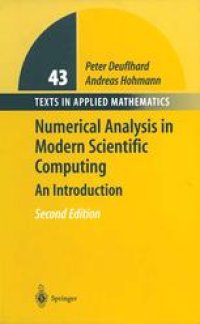
Ebook: Numerical Analysis in Modern Scientific Computing: An Introduction
- Tags: Numerical Analysis, Theoretical Mathematical and Computational Physics, Computational Intelligence, Computational Mathematics and Numerical Analysis
- Series: Texts in Applied Mathematics 43
- Year: 2003
- Publisher: Springer-Verlag New York
- Edition: 2
- Language: English
- pdf
This introductory book directs the reader to a selection of useful elementary numerical algorithms on a reasonably sound theoretical basis, built up within the text. The primary aim is to develop algorithmic thinking-emphasizing long-living computational concepts over fast changing software issues. The guiding principle is to explain modern numerical analysis concepts applicable in complex scientific computing at much simpler model problems. For example, the two adaptive techniques in numerical quadrature elaborated here carry the germs for either exploration methods or multigrid methods in differential equations, which are not treated here. The presentation draws on geometrical intuition wherever appropriate, supported by large number of illustrations. Numerous exercises are included for further practice and improved understanding.
This text will appeal to undergraduate and graduate students as well as researchers in mathematics, computer science, science, and engineering. At the same time, it is addressed to practical computational scientists who, via self-study, wish to become acquainted with modern concepts of numerical analysis and scientific computing on an elementary level. The sole prerequisite is undergraduate knowledge in linear algebra and calculus.
This introductory book directs the reader to a selection of useful elementary numerical algorithms on a reasonably sound theoretical basis, built up within the text. The primary aim is to develop algorithmic thinking-emphasizing long-living computational concepts over fast changing software issues. The guiding principle is to explain modern numerical analysis concepts applicable in complex scientific computing at much simpler model problems. For example, the two adaptive techniques in numerical quadrature elaborated here carry the germs for either exploration methods or multigrid methods in differential equations, which are not treated here. The presentation draws on geometrical intuition wherever appropriate, supported by large number of illustrations. Numerous exercises are included for further practice and improved understanding.
This text will appeal to undergraduate and graduate students as well as researchers in mathematics, computer science, science, and engineering. At the same time, it is addressed to practical computational scientists who, via self-study, wish to become acquainted with modern concepts of numerical analysis and scientific computing on an elementary level. The sole prerequisite is undergraduate knowledge in linear algebra and calculus.
This introductory book directs the reader to a selection of useful elementary numerical algorithms on a reasonably sound theoretical basis, built up within the text. The primary aim is to develop algorithmic thinking-emphasizing long-living computational concepts over fast changing software issues. The guiding principle is to explain modern numerical analysis concepts applicable in complex scientific computing at much simpler model problems. For example, the two adaptive techniques in numerical quadrature elaborated here carry the germs for either exploration methods or multigrid methods in differential equations, which are not treated here. The presentation draws on geometrical intuition wherever appropriate, supported by large number of illustrations. Numerous exercises are included for further practice and improved understanding.
This text will appeal to undergraduate and graduate students as well as researchers in mathematics, computer science, science, and engineering. At the same time, it is addressed to practical computational scientists who, via self-study, wish to become acquainted with modern concepts of numerical analysis and scientific computing on an elementary level. The sole prerequisite is undergraduate knowledge in linear algebra and calculus.
Content:
Front Matter....Pages i-xviii
Linear Systems....Pages 1-20
Error Analysis....Pages 21-56
Linear Least-Squares Problems....Pages 57-80
Nonlinear Systems and Least-Squares Problems....Pages 81-117
Linear Eigenvalue Problems....Pages 119-150
Three-Term Recurrence Relations....Pages 151-178
Interpolation and Approximation....Pages 179-235
Large Symmetric Systems of Equations and Eigenvalue Problems....Pages 237-268
Definite Integrals....Pages 269-323
Back Matter....Pages 325-339
This introductory book directs the reader to a selection of useful elementary numerical algorithms on a reasonably sound theoretical basis, built up within the text. The primary aim is to develop algorithmic thinking-emphasizing long-living computational concepts over fast changing software issues. The guiding principle is to explain modern numerical analysis concepts applicable in complex scientific computing at much simpler model problems. For example, the two adaptive techniques in numerical quadrature elaborated here carry the germs for either exploration methods or multigrid methods in differential equations, which are not treated here. The presentation draws on geometrical intuition wherever appropriate, supported by large number of illustrations. Numerous exercises are included for further practice and improved understanding.
This text will appeal to undergraduate and graduate students as well as researchers in mathematics, computer science, science, and engineering. At the same time, it is addressed to practical computational scientists who, via self-study, wish to become acquainted with modern concepts of numerical analysis and scientific computing on an elementary level. The sole prerequisite is undergraduate knowledge in linear algebra and calculus.
Content:
Front Matter....Pages i-xviii
Linear Systems....Pages 1-20
Error Analysis....Pages 21-56
Linear Least-Squares Problems....Pages 57-80
Nonlinear Systems and Least-Squares Problems....Pages 81-117
Linear Eigenvalue Problems....Pages 119-150
Three-Term Recurrence Relations....Pages 151-178
Interpolation and Approximation....Pages 179-235
Large Symmetric Systems of Equations and Eigenvalue Problems....Pages 237-268
Definite Integrals....Pages 269-323
Back Matter....Pages 325-339
....